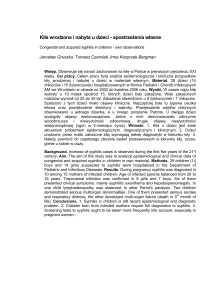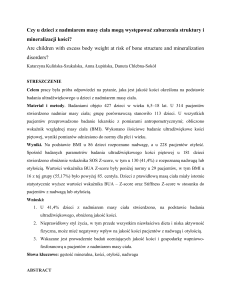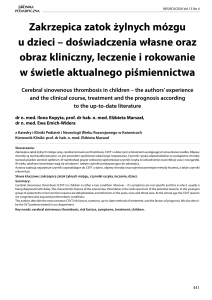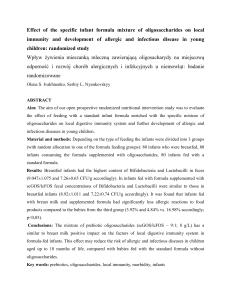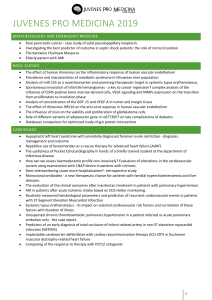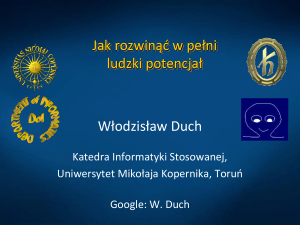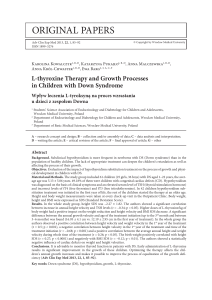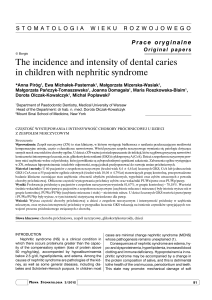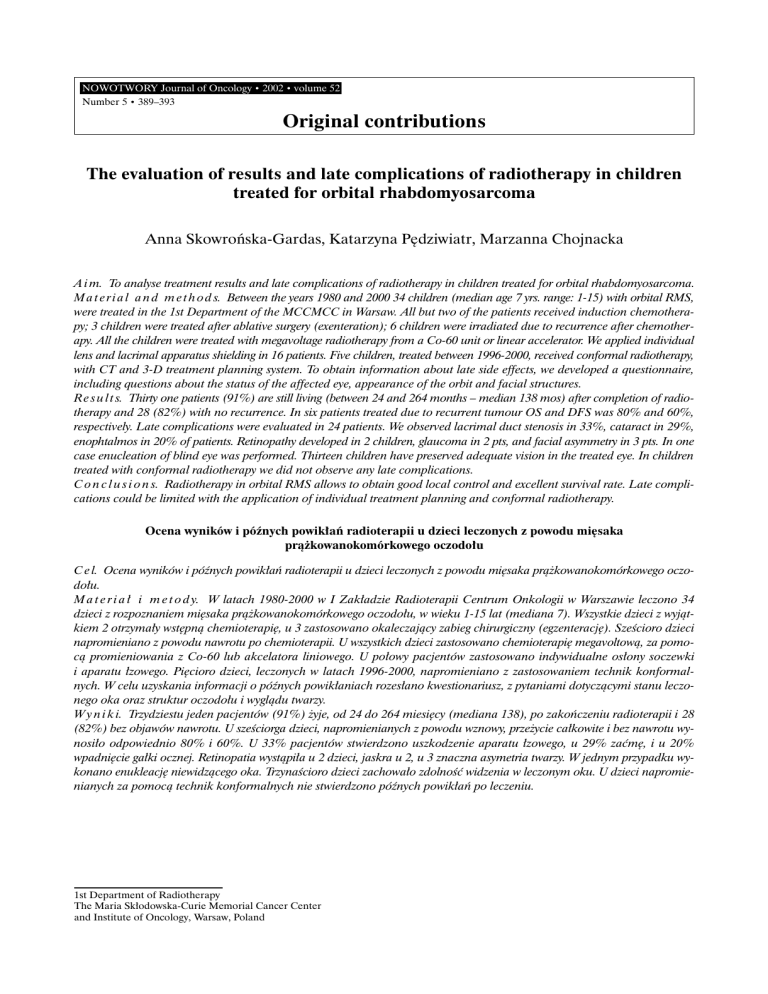
NOWOTWORY Journal of Oncology • 2002 • volume 52
Number 5 • 389–393
Original contributions
The evaluation of results and late complications of radiotherapy in children
treated for orbital rhabdomyosarcoma
Anna Skowroƒska-Gardas, Katarzyna P´dziwiatr, Marzanna Chojnacka
A i m. To analyse treatment results and late complications of radiotherapy in children treated for orbital rhabdomyosarcoma.
M a t e r i a l a n d m e t h o d s. Between the years 1980 and 2000 34 children (median age 7 yrs. range: 1-15) with orbital RMS,
were treated in the 1st Department of the MCCMCC in Warsaw. All but two of the patients received induction chemotherapy; 3 children were treated after ablative surgery (exenteration); 6 children were irradiated due to recurrence after chemotherapy. All the children were treated with megavoltage radiotherapy from a Co-60 unit or linear accelerator. We applied individual
lens and lacrimal apparatus shielding in 16 patients. Five children, treated between 1996-2000, received conformal radiotherapy,
with CT and 3-D treatment planning system. To obtain information about late side effects, we developed a questionnaire,
including questions about the status of the affected eye, appearance of the orbit and facial structures.
R e s u l t s. Thirty one patients (91%) are still living (between 24 and 264 months – median 138 mos) after completion of radiotherapy and 28 (82%) with no recurrence. In six patients treated due to recurrent tumour OS and DFS was 80% and 60%,
respectively. Late complications were evaluated in 24 patients. We observed lacrimal duct stenosis in 33%, cataract in 29%,
enophtalmos in 20% of patients. Retinopathy developed in 2 children, glaucoma in 2 pts, and facial asymmetry in 3 pts. In one
case enucleation of blind eye was performed. Thirteen children have preserved adequate vision in the treated eye. In children
treated with conformal radiotherapy we did not observe any late complications.
C o n c l u s i o n s. Radiotherapy in orbital RMS allows to obtain good local control and excellent survival rate. Late complications could be limited with the application of individual treatment planning and conformal radiotherapy.
Ocena wyników i póênych powik∏aƒ radioterapii u dzieci leczonych z powodu mi´saka
prà˝kowanokomórkowego oczodo∏u
C e l. Ocena wyników i póênych powik∏aƒ radioterapii u dzieci leczonych z powodu mi´saka prà˝kowanokomórkowego oczodo∏u.
M a t e r i a ∏ i m e t o d y. W latach 1980-2000 w I Zak∏adzie Radioterapii Centrum Onkologii w Warszawie leczono 34
dzieci z rozpoznaniem mi´saka prà˝kowanokomórkowego oczodo∏u, w wieku 1-15 lat (mediana 7). Wszystkie dzieci z wyjàtkiem 2 otrzyma∏y wst´pnà chemioterapi´, u 3 zastosowano okaleczajàcy zabieg chirurgiczny (egzenteracj´). SzeÊcioro dzieci
napromieniano z powodu nawrotu po chemioterapii. U wszystkich dzieci zastosowano chemioterapi´ megavoltowà, za pomocà promieniowania z Co-60 lub akcelatora liniowego. U po∏owy pacjentów zastosowano indywidualne os∏ony soczewki
i aparatu ∏zowego. Pi´cioro dzieci, leczonych w latach 1996-2000, napromieniano z zastosowaniem technik konformalnych. W celu uzyskania informacji o póênych powik∏aniach rozes∏ano kwestionariusz, z pytaniami dotyczàcymi stanu leczonego oka oraz struktur oczodo∏u i wyglàdu twarzy.
W y n i k i. Trzydziestu jeden pacjentów (91%) ˝yje, od 24 do 264 miesi´cy (mediana 138), po zakoƒczeniu radioterapii i 28
(82%) bez objawów nawrotu. U szeÊciorga dzieci, napromienianych z powodu wznowy, prze˝ycie ca∏kowite i bez nawrotu wynosi∏o odpowiednio 80% i 60%. U 33% pacjentów stwierdzono uszkodzenie aparatu ∏zowego, u 29% zaçm´, i u 20%
wpadni´cie ga∏ki ocznej. Retinopatia wystàpi∏a u 2 dzieci, jaskra u 2, u 3 znaczna asymetria twarzy. W jednym przypadku wykonano enukleacj´ niewidzàcego oka. TrzynaÊcioro dzieci zachowa∏o zdolnoÊç widzenia w leczonym oku. U dzieci napromienianych za pomocà technik konformalnych nie stwierdzono póênych powik∏aƒ po leczeniu.
1st Department of Radiotherapy
The Maria Sk∏odowska-Curie Memorial Cancer Center
and Institute of Oncology, Warsaw, Poland
390
W n i o s k i. Radioterapia, zastosowana u dzieci z rozpoznaniem mi´saka prà˝kowanokomórkowego oczodo∏u, pozwala na
uzyskanie dobrych wyników miejscowych i wysokiego odsetka prze˝yç ca∏kowitych. Póêne powik∏ania mogà zostaç zminimalizowane przez zastosowanie indywidualnych metod planowania i radioterapii konformalnej.
Key words: orbital rhabdomyosarcoma, radiotherapy, late complications
S∏owa kluczowe: mi´sak prà˝kowanokomórkowy oczodo∏u, radioterapia, póêne powik∏ania
Introduction
Rhabdomyosarcoma (RMS) is the most common softtissue sarcoma of childhood. RMS occurs in any anatomical location where there are skeletal muscles. More than
1/3 are located in head and neck sites, and in about 30%
of patients from this group an orbital tumour is found.
Historically, orbital RMS was treated with radical surgery,
usually exenteration. With this method, about 40% 5-year
survivals were obtained. Because it is difficult to remove
a tumour of the orbit with wide, uninvolved margins and
still preserve the eye and acceptable cosmesis, radiation
therapy was used to obtain local control with the aim of
preserving the eye [1]. This method allowed for better
results and more than 60% of children survived 5 years. In
the last two decades, multiagent chemotherapy with radiotherapy and, sometimes, conservative surgery allows to
obtain about 90% > 5 year survivals and 80% disease
free survival [2-7]. However, radiotherapy of the eye and
orbital structures is usually connected with serious late
side effects, such as cataract, lacrimal apparatus damage,
retinopathy, glaucoma and, even, optical nerve injury [8].
Although one may find literature reports of complications of radiation of the eye in children with orbital RMS
it was rather difficult to evaluate the real incidence and
severity of ocular radiation morbidity [9, 10].
The main purpose of this study was to evaluate treatment results and late complications in 34 children with
orbital rhabdomyosarcoma treated at the 1st Department
of Radiotherapy at the Maria Sklodowska-Curie
Memorial Cancer Center and Institute of Oncology in
Warsaw. Our secondary aim is was to design future management strategies for these patients, basing upon our
own experiences and published data.
Co60 or linear accelerator with photon and/or electron beams.
We used individual shells and masks for patient immobilisation
and reproducibility of treatment. In 29 patients treatment was
performed with two-dimensional planning system and the entire
orbit was included in planning treatment volume (PTV). In 5
children, treated since 1996, 3D conformal radiotherapy was
applied, and PTV comprised residual tumour with 1 cm margin
of normal tissue. In 18 patients we have spared the lens and
lacrimal apparatus. The total doses of 50-55 Gy were applied in
31 patients, in 1 pt. – 40Gy and in 1 pt. – 60 Gy, in fractionated
doses of 1.8-2.0 Gy. One patient had progression of disease during radiotherapy and did not complete treatment.
To obtain information about the late effects of treatment
we developed a questionnaire involving the status of the affected eye and the appearance of the orbit and the facial structures.
The questionnaire included questions about cataracts, visual acuity, keratitis, changes in other intraocular structures than
the retina, presence of ptosis, facial abnormalities and other
possible complications. The data was analysed to investigate
correlations among the age of the patients, the dose of irradiation and the type of the complication noted.
Overall survival (OS) and disease free survival (DFS),
measured from the onset of radiotherapy, were calculated using
the Kaplan-Meyer method. The survival free of visual distributions was also estimated with the Kaplan-Meyer method.
Results
Mean follow-up was 138 months (range: 1-264 months).
Minimum follow-up for a living patient was 24 months. At
present 31 children are still alive, among them 28 with
no evidence of disease. Local failure was observed in
6 children, 3 of them are alive after salvage surgery, 3 died
due to the disease. All failures were local, with no evidence of metastases. Actuarial 5- year OS and DFS rates
are 91% and 80%, respectively (Figures 1 and 2). In the
Material and methods
From January 1980 until December 2000 34 children aged
between 1 and 15 years (median age 7 yrs.) were treated in the
1st Department of Radiotherapy of the MSCMCC for orbital
rhabdomyosarcoma. The clinical stage acc. to the IRS system
was: I in 1 patient, II in 7 pts. and III in 26 pts. In 2 patients
exenteration was performed before radiotherapy, in 7 – gross
total excision, in 7 – partial excision, and in 18 – biopsy only.
Thirty two patients were treated with multiagent chemotherapy
regimes including cyclophosphamid, ifosphamid, vincristine,
adriamycin, actinomycin immediately after surgery. Two children (1980 and 1982) were treated without chemotherapy.
Chemotherapy and surgery were performed in paediatric oncology departments. Five patients were referred to radiotherapy
because of recidival tumour after prior surgery and chemotherapy. All children were treated with megavoltage radiotherapy –
Figure1. Overall survival of 34 patients with orbital RMS estimated by
the Kaplan-Meier method
391
Figure 2. Disease free survival of 34 patients with orbital
rhabdomyosarcoma estimated by the Kaplan-Meier method
Figure 4. Disease free survival of 34 patients with orbital RMS
according to treatment of reccurence after chemotherapy
group of patients irradiated immediately after neoadjuvant chemotherapy the actuarial 5-year overall (OS) was
93% and disease free survival (DFS) 82%. For patients
irradiated due to recurrent tumour OS was 80% and DFS
60%. These results are presented in Figures 3 and 4. In
order to evaluate late complications 3 children after
orbital exenteration or enucleation before radiotherapy,
and 6 children with local recurrence were excluded from
the analysis. In the remaining 24 patients we obtained
the information about their visual acuity and possible
complications. In most of them we observed only mild
complications, such as slight eye-lid asymmetry or minimal conjunctival teleangiectasies. Other late complications are presented in Table I.
The lens is the most radiosensitive structure of the
eye with an overt cataract developing after doses of 5-12
Gy. However, we observed cataract in relatively few
patients, probably because in 18 patients we shielded the
anterior part of the eye ball. In these patients the lens
recieved doses of some 5-20 Gy. Lacrimal duct stenosis
developed in 1/3 of our patients, the onset of symptoms
being observed a few months after radiotherapy, but in
a majority of cases the symptoms were mild. Enophtalmos
was observed in 20% of cases, both among younger and
older children. Serious facial asymmetry with maxillary
hypoplasia was observed in 3 children, all of whom were
under 6 years of age at the time of treatment. Retinopathy
was diagnosed in 2 children, both irradiated due to recurrent tumour. These children were also treated with salvage multiagent chemotherapy, thus the retinopathy may
have been brought on by both treatment methods.
Table I. Late complications in 24 children with orbital
rhabdomyosarcoma
Complication
Enophtalmos
Cataract
Lacrimal duct stenosis
Retinopathy
Glaucoma
Retinal ulceration
Facial asymmetry
Number of patients
%
5
7
8
2
2
1
3
20
29
33
8
8
5
12
Figure 5. Survival free of cataract in 24 patients estimated by the
Kaplan-Meier method
Figure 3. Overall survival of 34 patients with orbital RMS according to
treatment of recurrence after chemotherapy
The most serious complications were glaucoma and
painful retinal ulceration, leading – in one child – to eye
ball necrosis. In this latter case enucleation of the blind
eye was performed. Thirteen children have preserved
good vision in the treated eve. Visual acuity disturbances
were observed between 24 and 60 months after completion of radiotherapy, as is presented in Figure 5. Four
392
children, who were treated with 3D conformal radiotherapy have preserved good vision in the irradiated eye,
with no evidence of serious complications related to
radiotherapy. In one child we observed ptosis, but it
appeared before radiotherapy and was caused by previous
surgery.
Discussion
The experience derived from the co-operative trials of
the Intergroup Rhabdomyosarcoma Study and the trials
of International Society of Paediatric Oncology clearly
indicates that radiotherapy is the essential method for
local control of orbital sarcoma. The results obtained
with combined treatment are excellent, with 5-year OS
90-100% and DFS 80-90% [11, 12]. The results obtained
in our study – 91% OS and 80% DFS confirm these
patients’ good prognosis. Because of a possibility of serious side effects of radiation on the treated eye, investigators in Western Europe have chosen to give initially
chemotherapy to patients with orbital sarcoma in order to
postpone radiotherapy, indefinitely or until evidence of
failure. 38% of their patients were never treated with
radiotherapy and had a low rate of orbital complications.
But at least 45% of the initially non-irradiated patients
suffered local recurrence. Local recurrence usually
requires surgical intervention, sometimes mutilating, while
it still may call for irradiation. Only 70% of the initially
non-irradiated patients survived the recurrence, 30% died
due to uncontrolled disease. Two patients suffered cardiac
and renal failure after toxic chemotherapy, and one of
them died of doxorubicin cardiotoxicity [13]. In our study
we also observed worse outcome in children treated
due to local recurrence of an initially non-irradiated
tumour, with 5-year OS and DFS rates 80% and 60%,
respectively.
Few authors have reviewed the late sequelae of
radiotherapy in patients with orbital sarcoma [9, 10].
However, recently, two large studies focusing on the late
effects of therapy in children with orbital RMS have been
presented. The Italian authors have described a group
of 19 children, treated between 1980 and 1995, with an
excellent survival rate of 95% and continuous local control of 81%. These patients received a total dose of as
much as 60 Gy. The most common complications were
enophtalmos, lacrimal duct stenosis and facial asymmetry
in half of the patients. In the eye ball structures corneal
changes, lens opacities and iris damage were observed.
These complications caused a decrease in visual acuity
in 37% of the patients. Lens alterations have been registered in a relatively small number of subjects (47%), probably due to eyeball shielding [14]. Raney et al. have presented the results of a recent review of 94 survivors of
localised orbital sarcoma treated acc. to the IRS-III protocol between 1984 and 1991. 96% of their patients are
alive and in 86% the eye has been preserved. 82% of the
patients have developed cataract, but 66% of them have
undergone cataract surgery. 70% had varying degrees of
diminished visual acuity, but only 6% were blind in the
affected eye. Corneal and conjunctival changes and
lacrimal duct injury were observed in 1/3 of the patients.
Orbital hypoplasia was described in 60%, but only 9%
had maxillary hypoplasia, and 1 patient was said to have
significant facial disfigurement [15]. In our study the late
complications were similar. The relatively low rate of
cataract is probably the effect of shielding of the anterior
part of eyeball in some patients. The evaluation of height
and hormonal status was not the focus of our study, but
we have not observed significant deviations in growth
and puberty status in our patients. Similar results have
been reported by the Italian authors [14]. In the IRS
study decreased statural growth was observed in 24% of
children. These authors have also reported school difficulties in 14% of patients [15]. In our study one child
had problems at school, but it was more likely brought on
by mental retardation caused by microcephalus.
We must stress that radiation side effects have to be
carefully considered – parallel to the therapeutic goal.
Five children in our study were treated with 3D conformal
radiotherapy. One patient, treated due to recurrent
tumour, relapsed and died. Four are living with no recurrence, and we have not observed any late side effects,
except ptosis caused by previous surgery in one girl.
In our opinion the conformal or stereotactic radiotherapy with inclusion of the residual tumour only in
PTV should be appllied in children with orbital rhabdomyosarcoma.
Further studies are needed to investigate other
possible radiotherapy techniques in order to minimise
late complications of irradiation in this group of patients
[16, 17].
Conclusions
1.
2.
3.
Our study confirms previous reports of good results
obtained in children with orbital rhabdomyosarcoma
treated with chemo- and radiotherapy.
Late side effects of radiotherapy are observed in
some patients, but application of individual methods of treatment planning allows to preserve useful
vision in the treated eye in 50% of the patients.
3D conformal radiotherapy techniques may result
in further reduction of radiation-related sequelae.
Anna Skowroƒska-Gardas M.D. Ph.D.
1st Department of Radiotherapy
The Maria Sk∏odowska-Curie Memorial Cancer Center
and Institute of Oncology
Wawelska 15, 00-973 Warszawa
References
1. Halperin E, Constine L, Tarbell N, Kun L Paediatric Radiation Oncology,
3rd ed. Philadelphia: Lippincott Wiliams and Wilkins; 1999, 223-46.
2. Flamant F, Rodary C, Voute P A et al. Primary chemotherapy in the
treatment of rhabdomyosarcoma in children: Trial of the International
393
3.
4.
5.
6.
7.
8.
9.
10.
11.
12.
13.
14.
15.
16.
17.
Society of Paediatric Oncology (SIOP) preliminary results. Rad Oncol
1985; 3: 227-236.
Mauer HM, Beltangedy M, Gehan EA et al. The Intergroup
Rhabdomyosarcoma Study I. Cancer 1988; 61: 209-20.
Mauer HM, Gehan EA, Beltangady M et al. The Intergroup
Rhabdomyosarcoma Study II. Cancer 1993; 71: 1904-22.
Crist W, Gehan EA, Ragab AH et al. The Third Intergroup
Rhabdomyosarcoma Study. J Clin Oncol 1995; 13: 610-630
Florillo A, Migiliorati R, Grimal.di M et al. Multidisciplinary treatment of
primary orbital rhabdomyosarcoma. Cancer 1991; 67: 560-3.
Skowroƒska-Gardas A, Dramiƒska D. The value of irradiation in the
combined treatment of orbital rhabdomyosarcoma in the children with the
aim of vision preservation. In: Progress in Radio-Oncology, edit: Kogelnik
HD. Bologna: Monduzzi Edit; 1995, 257-60.
Parsons J, Fitzgeral.d C, Hood C et al. The effects of irradiation of the eye
and optic nerve Int J Rad Oncol Biol Phys 1983; 9: 609-33.
Heyn R, Ragab A, Ranev B et al. Late effects of therapy in orbital rhabdomyosarcoma. Cancer 1986; 57: 1738-43.
Paulino A Simon J, Zhen W, Wen B. Long-term effects in children treated with radiotherapy for head and neck rhabdomyosarcoma. Int J Rad
Oncol Biol Phys 2000; 48: 1489-95.
Wharam M, Hanfelt J, Tefft M et al. Radiation therapy for rhabdomyosarcoma: local failure risk for clinical group III patients on
Intergroup Rhabdomyosarcoma Study III. Int J Rad Oncol Biol Phys
1997; 38: 797-804.
Crist W, Anderson J, Meza J at al. Intergroup Rhabdomyosarcoma Study
IV: results for patients with nonmetastatic disease. J Clin Oncol 2001;
19: 3091-102.
Rousseau P, Flamant F, Quintana E et al. Primary chemotherapy in rhabdomyosarcomas and other malignant mezenchymal tumours of the orbit:
results of the International Society of Paediatric Oncology MMT 84
Study. J Clin Oncol 1994; 12: 516-21.
Florillo A, Migliorati R, Vasello P et al. Radiation late effects in children treated for orbital rhabdomyosarcoma. Rad Oncol 1999; 53: 143-8.
Raney RB, Anderson J, Kollath J et al. Late effects of radiotherapy in 94
patients with localised rhabdomyosarcoma of the orbit: report from the
Intergroup Rhabdomyosarcoma Study (IRS) -III 1984-1991. Med Ped
Oncol 2000; 34: 413-20.
Hug E, Adams J, Fitzek M et al. Fractionated, three dimensional planning
assisted proton radiation therapy for orbital rhabdomyosarcoma:a novel
technique. Int J Rad Oncol Biol Phys 2000; 47: 979-84.
Mirabell R, Cella L, Weber W. Lomax A Optimising radiotherapy of
orbital and paraorbital tumours: intensity modulated X-ray beams vs
intensity modulated proton beams. Int J Rad Oncol Biol Phys 2000; 47:
1111-9.
Paper received: 25 July 2002
Accepted: 26 August 2002

